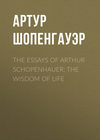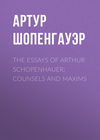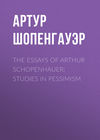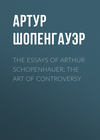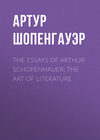Read the book: «The World as Will and Idea (Vol. 1 of 3)», page 18
We receive this impression of the mathematical-sublime, quite directly, by means of a space which is small indeed as compared with the world, but which has become directly perceptible to us, and affects us with its whole extent in all its three dimensions, so as to make our own body seem almost infinitely small. An empty space can never be thus perceived, and therefore never an open space, but only space that is directly perceptible in all its dimensions by means of the limits which enclose it; thus for example a very high, vast dome, like that of St. Peter's at Rome, or St. Paul's in London. The sense of the sublime here arises through the consciousness of the vanishing nothingness of our own body in the presence of a vastness which, from another point of view, itself exists only in our idea, and of which we are as knowing subject, the supporter. Thus here as everywhere it arises from the contrast between the insignificance and dependence of ourselves as individuals, as phenomena of will, and the consciousness of ourselves as pure subject of knowing. Even the vault of the starry heaven produces this if it is contemplated without reflection; but just in the same way as the vault of stone, and only by its apparent, not its real extent. Some objects of our perception excite in us the feeling of the sublime because, not only on account of their spatial vastness, but also of their great age, that is, their temporal duration, we feel ourselves dwarfed to insignificance in their presence, and yet revel in the pleasure of contemplating them: of this kind are very high mountains, the Egyptian pyramids, and colossal ruins of great antiquity.
Our explanation of the sublime applies also to the ethical, to what is called the sublime character. Such a character arises from this, that the will is not excited by objects which are well calculated to excite it, but that knowledge retains the upper hand in their presence. A man of sublime character will accordingly consider men in a purely objective way, and not with reference to the relations which they might have to his will; he will, for example, observe their faults, even their hatred and injustice to himself, without being himself excited to hatred; he will behold their happiness without envy; he will recognise their good qualities without desiring any closer relations with them; he will perceive the beauty of women, but he will not desire them. His personal happiness or unhappiness will not greatly affect him, he will rather be as Hamlet describes Horatio: —
“… for thou hast been,
As one, in suffering all, that suffers nothing;
A man that fortune's buffets and rewards
Hast ta'en with equal thanks,” &c. (A. 3. Sc. 2.)
For in the course of his own life and its misfortunes, he will consider less his individual lot than that of humanity in general, and will therefore conduct himself in its regard, rather as knowing than as suffering.
§ 40. Opposites throw light upon each other, and therefore the remark may be in place here, that the proper opposite of the sublime is something which would not at the first glance be recognised, as such: the charming or attractive. By this, however, I understand, that which excites the will by presenting to it directly its fulfilment, its satisfaction. We saw that the feeling of the sublime arises from the fact, that something entirely unfavourable to the will, becomes the object of pure contemplation, so that such contemplation can only be maintained by persistently turning away from the will, and transcending its interests; this constitutes the sublimity of the character. The charming or attractive, on the contrary, draws the beholder away from the pure contemplation which is demanded by all apprehension of the beautiful, because it necessarily excites this will, by objects which directly appeal to it, and thus he no longer remains pure subject of knowing, but becomes the needy and dependent subject of will. That every beautiful thing which is bright or cheering should be called charming, is the result of a too general concept, which arises from a want of accurate discrimination, and which I must entirely set aside, and indeed condemn. But in the sense of the word which has been given and explained, I find only two species of the charming or attractive in the province of art, and both of them are unworthy of it. The one species, a very low one, is found in Dutch paintings of still life, when they err by representing articles of food, which by their deceptive likeness necessarily excite the appetite for the things they represent, and this is just an excitement of the will, which puts an end to all æsthetic contemplation of the object. Painted fruit is yet admissible, because we may regard it as the further development of the flower, and as a beautiful product of nature in form and colour, without being obliged to think of it as eatable; but unfortunately we often find, represented with deceptive naturalness, prepared and served dishes, oysters, herrings, crabs, bread and butter, beer, wine, and so forth, which is altogether to be condemned. In historical painting and in sculpture the charming consists in naked figures, whose position, drapery, and general treatment are calculated to excite the passions of the beholder, and thus pure æsthetical contemplation is at once annihilated, and the aim of art is defeated. This mistake corresponds exactly to that which we have just censured in the Dutch paintings. The ancients are almost always free from this fault in their representations of beauty and complete nakedness of form, because the artist himself created them in a purely objective spirit, filled with ideal beauty, not in the spirit of subjective, and base sensuality. The charming is thus everywhere to be avoided in art.
There is also a negative species of the charming or exciting which is even more reprehensible than the positive form which has been discussed; this is the disgusting or the loathsome. It arouses the will of the beholder, just as what is properly speaking charming, and therefore disturbs pure æsthetic contemplation. But it is an active aversion and opposition which is excited by it; it arouses the will by presenting to it objects which it abhors. Therefore it has always been recognised that it is altogether inadmissible in art, where even what is ugly, when it is not disgusting, is allowable in its proper place, as we shall see later.
§ 41. The course of the discussion has made it necessary to insert at this point the treatment of the sublime, though we have only half done with the beautiful, as we have considered its subjective side only. For it was merely a special modification of this subjective side that distinguished the beautiful from the sublime. This difference was found to depend upon whether the state of pure will-less knowing, which is presupposed and demanded by all æsthetic contemplation, was reached without opposition, by the mere disappearance of the will from consciousness, because the object invited and drew us towards it; or whether it was only attained through the free, conscious transcending of the will, to which the object contemplated had an unfavourable and even hostile relation, which would destroy contemplation altogether, if we were to give ourselves up to it. This is the distinction between the beautiful and the sublime. In the object they are not essentially different, for in every case the object of æsthetical contemplation is not the individual thing, but the Idea in it which is striving to reveal itself; that is to say, adequate objectivity of will at a particular grade. Its necessary correlative, independent, like itself of the principle of sufficient reason, is the pure subject of knowing; just as the correlative of the particular thing is the knowing individual, both of which lie within the province of the principle of sufficient reason.
When we say that a thing is beautiful, we thereby assert that it is an object of our æsthetic contemplation, and this has a double meaning; on the one hand it means that the sight of the thing makes us objective, that is to say, that in contemplating it we are no longer conscious of ourselves as individuals, but as pure will-less subjects of knowledge; and on the other hand it means that we recognise in the object, not the particular thing, but an Idea; and this can only happen, so far as our contemplation of it is not subordinated to the principle of sufficient reason, does not follow the relation of the object to anything outside it (which is always ultimately connected with relations to our own will), but rests in the object itself. For the Idea and the pure subject of knowledge always appear at once in consciousness as necessary correlatives, and on their appearance all distinction of time vanishes, for they are both entirely foreign to the principle of sufficient reason in all its forms, and lie outside the relations which are imposed by it; they may be compared to the rainbow and the sun, which have no part in the constant movement and succession of the falling drops. Therefore, if, for example, I contemplate a tree æsthetically, i. e., with artistic eyes, and thus recognise, not it, but its Idea, it becomes at once of no consequence whether it is this tree or its predecessor which flourished a thousand years ago, and whether the observer is this individual or any other that lived anywhere and at any time; the particular thing and the knowing individual are abolished with the principle of sufficient reason, and there remains nothing but the Idea and the pure subject of knowing, which together constitute the adequate objectivity of will at this grade. And the Idea dispenses not only with time, but also with space, for the Idea proper is not this special form which appears before me but its expression, its pure significance, its inner being, which discloses itself to me and appeals to me, and which may be quite the same though the spatial relations of its form be very different.
Since, on the one hand, every given thing may be observed in a. purely objective manner and apart from all relations; and since, on the other hand, the will manifests itself in everything at some grade of its objectivity, so that everything is the expression of an Idea; it follows that everything is also beautiful. That even the most insignificant things admit of pure objective and will-less contemplation, and thus prove that they are beautiful, is shown by what was said above in this reference about the Dutch pictures of still-life (52). But one thing is more beautiful than another, because it makes this pure objective contemplation easier, it lends itself to it, and, so to speak, even compels it, and then we call it very beautiful. This is the case sometimes because, as an individual thing, it expresses in its purity the Idea of its species by the very distinct, clearly defined, and significant relation of its parts, and also fully reveals that Idea through the completeness of all the possible expressions of its species united in it, so that it makes the transition from the individual thing to the Idea, and therefore also the condition of pure contemplation, very easy for the beholder. Sometimes this possession of special beauty in an object lies in the fact that the Idea itself which appeals to us in it is a high grade of the objectivity of will, and therefore very significant and expressive. Therefore it is that man is more beautiful than all other objects, and the revelation of his nature is the highest aim of art. Human form and expression are the most important objects of plastic art, and human action the most important object of poetry. Yet each thing has its own peculiar beauty, not only every organism which expresses itself in the unity of an individual being, but also everything unorganised and formless, and even every manufactured article. For all these reveal the Ideas through which the will objectifies itself at its lowest grades, they give, as it were, the deepest resounding bass-notes of nature. Gravity, rigidity, fluidity, light, and so forth, are the Ideas which express themselves in rocks, in buildings, in waters. Landscape-gardening or architecture can do no more than assist them to unfold their qualities distinctly, fully, and variously; they can only give them the opportunity of expressing themselves purely, so that they lend themselves to æsthetic contemplation and make it easier. Inferior buildings or ill-favoured localities, on the contrary, which nature has neglected or art has spoiled, perform this task in a very slight degree or not at all; yet even from them these universal, fundamental Ideas of nature cannot altogether disappear. To the careful observer they present themselves here also, and even bad buildings and the like are capable of being æsthetically considered; the Ideas of the most universal properties of their materials are still recognisable in them, only the artificial form which has been given them does not assist but hinders æsthetic contemplation. Manufactured articles also serve to express Ideas, only it is not the Idea of the manufactured article which speaks in them, but the Idea of the material to which this artificial form has been given. This may be very conveniently expressed in two words, in the language of the schoolmen, thus, – the manufactured article expresses the Idea of its forma substantialis, but not that of its forma accidentalis; the latter leads to no Idea, but only to a human conception of which it is the result. It is needless to say that by manufactured article no work of plastic art is meant. The schoolmen understand, in fact, by forma substantialis that which I call the grade of the objectification of will in a thing. We shall return immediately, when we treat of architecture, to the Idea of the material. Our view, then, cannot be reconciled with that of Plato if he is of opinion that a table or a chair express the Idea of a table or a chair (De Rep., x., pp. 284, 285, et Parmen., p. 79, ed. Bip.), but we say that they express the Ideas which are already expressed in their mere material as such. According to Aristotle (Metap. xi., chap. 3), however, Plato himself only maintained Ideas of natural objects: ὁ Πλατων εφη, ὁτι ειδη εστιν ὁποσα φυσει (Plato dixit, quod ideæ eorum sunt, quæ natura sunt), and in chap. 5 he says that, according to the Platonists, there are no Ideas of house and ring. In any case, Plato's earliest disciples, as Alcinous informs us (Introductio in Platonicam Philosophiam, chap. 9), denied that there were any ideas of manufactured articles. He says: Ὁριζονται δε την ιδεαν, παραδειγμα των κατα φυσιν αιωνιον. Ουτε γαρ τοις πλειστοις των απο Πλατωνος αρεσκει, των τεχνικων ειναι ιδεας, οἱον ασπιδος η λυρας, ουτε μην των παρα φυσιν, οἱον πυρετου και χολερας, ουτε των κατα μερος, οἱον Σωκρατους και Πλατωνος, αλλ᾽ ουτε των ευτελων τινος, οἱον ρυπου και καρφους, ουτε των προς τι, οἱον μειζονος και ὑπερεχοντος; ειναι γαρ τας ιδεας νοησεις θεου αιωνιους τε και αυτοτελεις (Definiunt autem ideam exemplar æternum eorum, quæ secundum naturam existunt. Nam plurimis ex iis, qui Platonem secuti sunt, minime placuit, arte factorum ideas esse, ut clypei atque lyræ; neque rursus eorum, quæ prætor naturam, ut febris et choleræ, neque particularium, ceu Socratis et Platonis; neque etiam rerum vilium, veluti sordium et festucæ; neque relationum, ut majoris et excedentis: esse namque ideas intellectiones dei æternas, ac seipsis perfectas). We may take this opportunity of mentioning another point in which our doctrine of Ideas differs very much from that of Plato. He teaches (De Rep., x., p. 288) that the object which art tries to express, the ideal of painting and poetry, is not the Idea but the particular thing. Our whole exposition hitherto has maintained exactly the opposite, and Plato's opinion is the less likely to lead us astray, inasmuch as it is the source of one of the greatest and best known errors of this great man, his depreciation and rejection of art, and especially poetry; he directly connects his false judgment in reference to this with the passage quoted.
§ 42. I return to the exposition of the æsthetic impression. The knowledge of the beautiful always supposes at once and inseparably the pure knowing subject and the known Idea as object. Yet the source of æsthetic satisfaction will sometimes lie more in the comprehension of the known Idea, sometimes more in the blessedness and spiritual peace of the pure knowing subject freed from all willing, and therefore from all individuality, and the pain that proceeds from it. And, indeed, this predominance of one or the other constituent part of æsthetic feeling will depend upon whether the intuitively grasped Idea is a higher or a lower grade of the objectivity of will. Thus in æsthetic contemplation (in the real, or through the medium of art) of the beauty of nature in the inorganic and vegetable worlds, or in works of architecture, the pleasure of pure will-less knowing will predominate, because the Ideas which are here apprehended are only low grades of the objectivity of will, and are therefore not manifestations of deep significance and rich content. On the other hand, if animals and man are the objects of æsthetic contemplation or representation, the pleasure will consist rather in the comprehension of these Ideas, which are the most distinct revelation of will; for they exhibit the greatest multiplicity of forms, the greatest richness and deep significance of phenomena, and reveal to us most completely the nature of will, whether in its violence, its terribleness, its satisfaction or its aberration (the latter in tragic situations), or finally in its change and self-surrender, which is the peculiar theme of christian painting; as the Idea of the will enlightened by full knowledge is the object of historical painting in general, and of the drama. We shall now go through the fine arts one by one, and this will give completeness and distinctness to the theory of the beautiful which we have advanced.
§ 43. Matter as such cannot be the expression of an Idea. For, as we found in the first book, it is throughout nothing but causality: its being consists in its casual action. But causality is a form of the principle of sufficient reason; knowledge of the Idea, on the other hand, absolutely excludes the content of that principle. We also found, in the second book, that matter is the common substratum of all particular phenomena of the Ideas, and consequently is the connecting link between the Idea and the phenomenon, or the particular thing. Accordingly for both of these reasons it is impossible that matter can for itself express any Idea. This is confirmed a posteriori by the fact that it is impossible to have a perceptible idea of matter as such, but only an abstract conception; in the former, i. e., in perceptible ideas are exhibited only the forms and qualities of which matter is the supporter, and in all of which Ideas reveal themselves. This corresponds also with the fact, that causality (the whole essence of matter) cannot for itself be presented perceptibly, but is merely a definite casual connection. On the other hand, every phenomenon of an Idea, because as such it has entered the form of the principle of sufficient reason, or the principium individuationis, must exhibit itself in matter, as one of its qualities. So far then matter is, as we have said, the connecting link between the Idea and the principium individuationis, which is the form of knowledge of the individual, or the principle of sufficient reason. Plato is therefore perfectly right in his enumeration, for after the Idea and the phenomenon, which include all other things in the world, he gives matter only, as a third thing which is different from both (Timaus, p. 345). The individual, as a phenomenon of the Idea, is always matter. Every quality of matter is also the phenomenon of an Idea, and as such it may always be an object of æsthetic contemplation, i. e., the Idea expressed in it may always be recognised. This holds good of even the most universal qualities of matter, without which it never appears, and which are the weakest objectivity of will. Such are gravity, cohesion, rigidity, fluidity, sensitiveness to light, and so forth.
If now we consider architecture simply as a fine art and apart from its application to useful ends, in which it serves the will and not pure knowledge, and therefore ceases to be art in our sense; we can assign to it no other aim than that of bringing to greater distinctness some of those ideas, which are the lowest grades of the objectivity of will; such as gravity, cohesion, rigidity, hardness, those universal qualities of stone, those first, simplest, most inarticulate manifestations of will; the bass notes of nature; and after these light, which in many respects is their opposite. Even at these low grades of the objectivity of will we see its nature revealing itself in discord; for properly speaking the conflict between gravity and rigidity is the sole æsthetic material of architecture; its problem is to make this conflict appear with perfect distinctness in a multitude of different ways. It solves it by depriving these indestructible forces of the shortest way to their satisfaction, and conducting them to it by a circuitous route, so that the conflict is lengthened and the inexhaustible efforts of both forces become visible in many different ways. The whole mass of the building, if left to its original tendency, would exhibit a mere heap or clump, bound as closely as possible to the earth, to which gravity, the form in which the will appears here, continually presses, while rigidity, also objectivity of will, resists. But this very tendency, this effort, is hindered by architecture from obtaining direct satisfaction, and only allowed to reach it indirectly and by roundabout ways. The roof, for example, can only press the earth through columns, the arch must support itself, and can only satisfy its tendency towards the earth through the medium of the pillars, and so forth. But just by these enforced digressions, just by these restrictions, the forces which reside in the crude mass of stone unfold themselves in the most distinct and multifarious ways; and the purely æsthetic aim of architecture can go no further than this. Therefore the beauty, at any rate, of a building lies in the obvious adaptation of every part, not to the outward arbitrary end of man (so far the work belongs to practical architecture), but directly to the stability of the whole, to which the position, dimensions, and form of every part must have so necessary a relation that, where it is possible, if any one part were taken away, the whole would fall to pieces. For just because each part bears just as much as it conveniently can, and each is supported just where it requires to be and just to the necessary extent, this opposition unfolds itself, this conflict between rigidity and gravity, which constitutes the life, the manifestation of will, in the stone, becomes completely visible, and these lowest grades of the objectivity of will reveal themselves distinctly. In the same way the form of each part must not be determined arbitrarily, but by its end, and its relation to the whole. The column is the simplest form of support, determined simply by its end: the twisted column is tasteless; the four-cornered pillar is in fact not so simple as the round column, though it happens that it is easier to make it. The forms also of frieze, rafter, roof, and dome are entirely determined by their immediate end, and explain themselves from it. The decoration of capitals, &c., belongs to sculpture, not to architecture, which admits it merely as extraneous ornament, and could dispense with it. According to what has been said, it is absolutely necessary, in order to understand the æsthetic satisfaction afforded by a work of architecture, to have immediate knowledge through perception of its matter as regards its weight, rigidity, and cohesion, and our pleasure in such a work would suddenly be very much diminished by the discovery that the material used was pumice-stone; for then it would appear to us as a kind of sham building. We would be affected in almost the same way if we were told that it was made of wood, when we had supposed it to be of stone, just because this alters and destroys the relation between rigidity and gravity, and consequently the significance and necessity of all the parts, for these natural forces reveal themselves in a far weaker degree in a wooden building. Therefore no real work of architecture as a fine art can be made of wood, although it assumes all forms so easily; this can only be explained by our theory. If we were distinctly told that a building, the sight of which gave us pleasure, was made of different kinds of material of very unequal weight and consistency, but not distinguishable to the eye, the whole building would become as utterly incapable of affording us pleasure as a poem in an unknown language. All this proves that architecture does not affect us mathematically, but also dynamically, and that what speaks to us through it, is not mere form and symmetry, but rather those fundamental forces of nature, those first Ideas, those lowest grades of the objectivity of will. The regularity of the building and its parts is partly produced by the direct adaptation of each member to the stability of the whole, partly it serves to facilitate the survey and comprehension of the whole, and finally, regular figures to some extent enhance the beauty because they reveal the constitution of space as such. But all this is of subordinate value and necessity, and by no means the chief concern; indeed, symmetry is not invariably demanded, as ruins are still beautiful.
Works of architecture have further quite a special relation to light; they gain a double beauty in the full sunshine, with the blue sky as a background, and again they have quite a different effect by moonlight. Therefore, when a beautiful work of architecture is to be erected, special attention is always paid to the effects of the light and to the climate. The reason of all this is, indeed, principally that all the parts and their relations are only made clearly visible by a bright, strong light; but besides this I am of opinion that it is the function of architecture to reveal the nature of light just as it reveals that of things so opposite to it as gravity and rigidity. For the light is intercepted, confined, and reflected by the great opaque, sharply outlined, and variously formed masses of stone, and thus it unfolds its nature and qualities in the purest and clearest way, to the great pleasure of the beholders, for light is the most joy-giving of things, as the condition and the objective correlative of the most perfect kind of knowledge of perception.
Now, because the Ideas which architecture brings to clear perception, are the lowest grades of the objectivity of will, and consequently their objective significance, which architecture reveals to us, is comparatively small; the æsthetic pleasure of looking at a beautiful building in a good light will lie, not so much in the comprehension of the Idea, as in the subjective correlative which accompanies this comprehension; it will consist pre-eminently in the fact that the beholder, set free from the kind of knowledge that belongs to the individual, and which serves the will and follows the principle of sufficient reason, is raised to that of the pure subject of knowing free from will. It will consist then principally in pure contemplation itself, free from all the suffering of will and of individuality. In this respect the opposite of architecture, and the other extreme of the series of the fine arts, is the drama, which brings to knowledge the most significant Ideas. Therefore in the æsthetic pleasure afforded by the drama the objective side is throughout predominant.
Architecture has this distinction from plastic art and poetry: it does not give us a copy but the thing itself. It does not repeat, as they do, the known Idea, so that the artist lends his eyes to the beholder, but in it the artist merely presents the object to the beholder, and facilitates for him the comprehension of the Idea by bringing the actual, individual object to a distinct and complete expression of its nature.
Unlike the works of the other arts, those of architecture are very seldom executed for purely æsthetic ends. These are generally subordinated to other useful ends which are foreign to art itself. Thus the great merit of the architect consists in achieving and attaining the pure æsthetic ends, in spite of their subordination to other ends which are foreign to them. This he does by cleverly adapting them in a variety of ways to the arbitrary ends in view, and by rightly judging which form of æsthetical architectonic beauty is compatible and may be associated with a temple, which with a palace, which with a prison, and so forth. The more a harsh climate increases these demands of necessity and utility, determines them definitely, and prescribes them more inevitably, the less free play has beauty in architecture. In the mild climate of India, Egypt, Greece, and Rome, where the demands of necessity were fewer and less definite, architecture could follow its æsthetic ends with the greatest freedom. But under a northern sky this was sorely hindered. Here, when caissons, pointed roofs and towers were what was demanded, architecture could only unfold its own beauty within very narrow limits, and therefore it was obliged to make amends by resorting all the more to the borrowed ornaments of sculpture, as is seen in Gothic architecture.
We thus see that architecture is greatly restricted by the demands of necessity and utility; but on the other hand it has in them a very powerful support, for, on account of the magnitude and costliness of its works, and the narrow sphere of its æsthetic effect, it could not continue to exist merely as a fine art, if it had not also, as a useful and necessary profession, a firm and honourable place among the occupations of men. It is the want of this that prevents another art from taking its place beside architecture as a sister art, although in an æsthetical point of view it is quite properly to be classed along with it as its counterpart; I mean artistic arrangements of water. For what architecture accomplishes for the Idea of gravity when it appears in connection with that of rigidity, hydraulics accomplishes for the same Idea, when it is connected with fluidity, i. e., formlessness, the greatest mobility and transparency. Leaping waterfalls foaming and tumbling over rocks, cataracts dispersed into floating spray, springs gushing up as high columns of water, and clear reflecting lakes, reveal the Ideas of fluid and heavy matter, in precisely the same way as the works of architecture unfold the Ideas of rigid matter. Artistic hydraulics, however, obtains no support from practical hydraulics, for, as a rule, their ends cannot be combined; yet, in exceptional cases, this happens; for example, in the Cascata di Trevi at Rome.53











